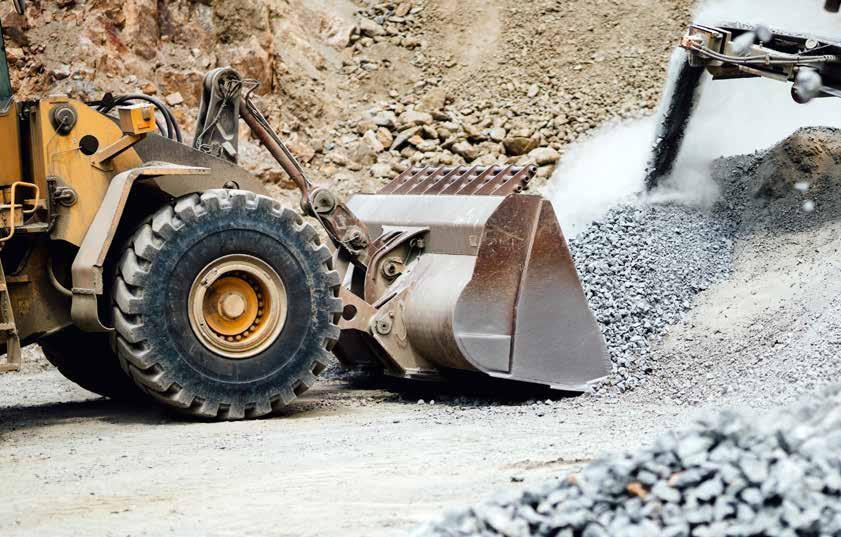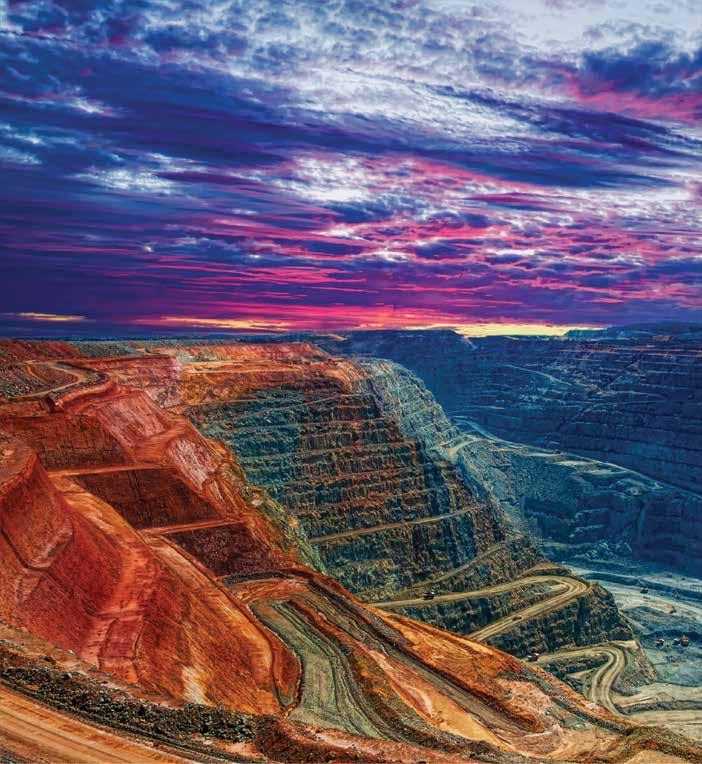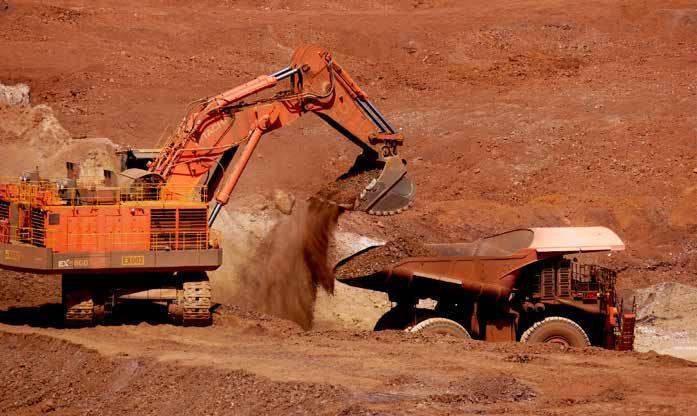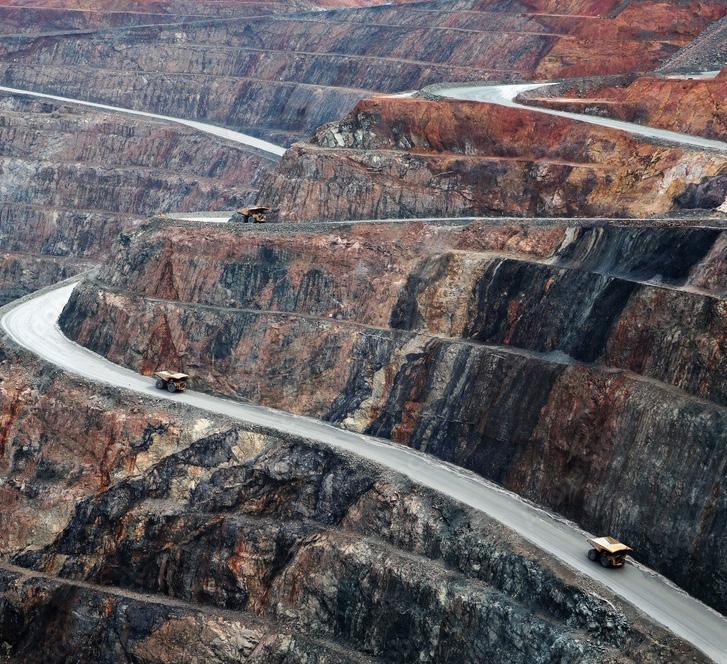
13 minute read
EXCLUSIVE NTERVIEW
Serge DeSilvaRanasinghe,
Managing Editor, WA DEFENCE REVIEW
Paul Everingham.
PAUL EVERINGHAM: “THE RESOURCES SECTOR HAS AN OPEN APPROACH TO WORKING WITH DEFENCE TO HELP ENSURE OUR MUTUAL OBJECTIVES ARE ACHIEVED.”
Despite the uncertainty surrounding the pandemic, the Western Australian resources sector continues to be one the pillars of both the state and national economies, with iron ore exports climbing to record levels and a global focus on renewables creating opportunities for many other commodities, such as rare earths. WA DEFENCE REVIEW spoke with Paul Everingham, the Chief Executive of the Chamber of Minerals and Energy of Western Australia (CMEWA), to discuss the state of the resources sector in WA, its synergies with Defence, and the outlook ahead to future opportunities and challenges.
Rest of Australia
Australia 51.98 $31.83 $83.8
billion billion
774 Community organisations supported
Local governments supported
Government payments from WA operations
Commonwealth company tax, FBT, offshore royalties $18.03 billion
Can you outline the current state of Australia’s minerals and energy sector and the contribution the sector in WA makes to the national economy?
The state of WA’s resources sector is healthy at present, with an optimistic outlook over the mediumterm future albeit with the significant uncertainty of the coronavirus pandemic. Many of the WA sector’s traditional areas of strength – notably iron ore and gold – continue to perform extremely well, and new and exciting opportunities continue to emerge in the battery minerals space.
The predicted growth in electric vehicle uptake is expected to drive increased demand in WA’s lithium industry, while an increased global focus on renewable energy is also good news for commodities such as nickel, copper, bauxite, cobalt and rare earths. Additionally, there are a number of resources companies with WA operations that are investing in the hydrogen industry, which has great future potential for WA and Australia. WA’s resources sector contributed $12.7bn in royalties, North West Shelf grants and lease rentals to the WA government in the FY2020-21 - accounting for 31% of all state revenue. In WA alone, an average of more than 140,000 people were employed in the sector during the 2020 calendar year.
Meanwhile, company tax payments from resources companies operating in WA helped the federal government fund important COVID-19 recovery mechanisms, such as JobKeeper and JobSeeker. A report released earlier this year by the Minerals Council of Australia found that company tax and royalty payments by Australian mining contributed more than $39bn to governments across the country. In the FY2019-20, mining was the single biggest contributing industry to Australia’s economy, with a gross domestic product totalling more than $20bn.
Which specific commodities are currently experiencing growth and why? How sustainable is this growth likely to be into the future?
Exports of iron ore have climbed to record levels over the past year, while Australia became the biggest gold producer in the world during the first six months of this year. There is also continued growth for lithium, nickel, cobalt and rare earths as demand for
electrical vehicles, renewable energy and technology in general continues to grow across the world.
In terms of sustainability, iron ore has been a strong performer for several decades and gold has always been a commodity closely associated with WA’s economy. Our healthy natural reserves of iron ore and gold and our ability to mine, refine and export them in an efficient manner within a stable political and fiscal environment, means they should continue to be key long-term contributors to the WA and Australian economies. The trend towards electric vehicles, renewables and technology means growth in demand for commodities such as lithium, nickel, bauxite, cobalt and rare earths should be sustainable well into the future.
Iron ore has been a major economic success story for Australia, however there are increasingly credible indications that Australia’s main buyer – China – is now firmly committed to reducing its dependence on Australian iron ore. What does this mean for the outlook of Australian iron ore?

The WA resources sector has a longstanding, strong trading relationship with China across a variety of commodities, including iron ore, gas and nickel. CMEWA and its member companies look forward to that strong trading relationship continuing into the future.
What impact is the growing focus on renewables and energy transformation having on the future of the minerals and energy sector in Australia?
The impact of the growing focus on renewables and energy transformation on the WA resources sector has been two-fold.
As mentioned, it is likely to drive significant growth for demand in commodities such as lithium, bauxite, cobalt, nickel and rare earths – all of which can be found with relative abundance in WA. In the case of nickel, we’ve seen new mines open in the Kambalda area, and BHP Nickel West enter into a supply agreement with Tesla. When complete, Albermarle’s lithium production facilities at Kemerton is expected to be among the world’s largest. In the past month we’ve seen the likes of IGO produce its first lithium hydroxide at Kwinana as part of its joint venture with Tianqi, while Covalent Lithium announced it would build a new refinery.
On the rare earth front Northern Minerals is one of few producers of the heavy rare earth element Dysprosium outside China, while Hastings has secured offtake memorandum of understandings and is working towards production of rare earth carbonate at Yangibana in 2022, and Iluka is expediting a feasibility study for a rare earth refinery at Eneabba. This is atop the success of Lynas, which is the largest producer of rare earths outside of China and is investing in a rare earths
Total direct economic contribution to Australia
Wages & salaries
Business purchases Payments to Government
Community contributions
Western Australia
Rest of Australia
Australia $51.98 $31.83 $83.8
billion billion billion
A report released earlier this year by the Minerals Council of Australia found that company tax and royalty payments by Australian mining contributed more than $39bn to governments across the country. In the FY2019-20, mining was the single biggest contributing industry to Australia’s economy, with a gross domestic product totalling more than $20bn.
processing facility at Kalgoorlie. And there will be more to come in this space too, because exploration in WA in 2020 was at its highest since 2012, with nickel, cobalt and copper ranking behind only gold and iron ore as the target of activity.
The other way in which the focus on renewables and energy transformation is affecting our sector is in the way operations are being designed. A variety of projects are taking up renewable energy as an alternative to traditional diesel power, including Gold Fields’ Agnew Mine, which is home to Australia’s largest hybrid renewable energy microgrid – the first mine site in Australia to use wind generation on a large scale. Whether it’s introducing electric light vehicles or implementing solar power, WA mining and resources sector operators are constantly looking at ways they can improve their energy mix to reduce emissions. One of the most exciting developments is around hydrogen, with ATCO and Yara Pilbara being awarded more than $100m by the federal and state governments to advance commercial-scale renewable hydrogen projects.
As China is actively competing with the developed world for exclusive access and exploitation of rare earths and strategic mineral reserves, how well placed is Australia’s resources sector to benefit from this geo-political contestation?
The significance of rare earths – including for use in defence industry – has been widely publicised over the past few years. WA has several potentially globally significant projects in this space, including Lynas’ operations at Mount Weld (a planned Kalgoorlie processing plant), Northern Minerals’ Browns Range Pilot Plant project and Hastings Technology Metals’ Yangibana and Brockman projects.
We expect the demand for rare earths to continue to grow, which will require new sources of supply. With our worldclass expertise, efficient operations, and reputation as a reliable and secure supplier, WA is well positioned to benefit from this growth. In a similar way to the drivers for building local Defence capability and capacity, given the sensitivity and strategic nature of many end use cases for rare earths, we are seeing increasing attention from government on how to further increase Australia’s participation in downstream processing.
As the largest and most profitable industry sector in the Australian economy, the resources sector is also a major generator in the advancement of new and cutting edge technologies. Can you illustrate what these technologies are and how they could be leveraged with relation to future Australian industries?
The resources sector in WA is continually is already well-established as a global leader in the fields of automation and robotics and is very much at the forefront of Australia’s first forays into the renewable hydrogen sector and the battery chemistry sector.
The space sector in Australia is yet another example of synergistic opportunity. The CMEWA notes the recent launch of WA’s first home-built satellite Binar-1, which could assist with the operation of autonomous equipment in Australia and helping to identify mineral deposits. The people behind Binar-1 have also been open in their hope that its launch might be a first step towards extracting important resources such as hydrogen and oxygen from the moon. There are some clear potential synergies between the work the resources sector and the space sector are and will be doing in the areas of automation and robotics. One prominent case example of this is the work Woodside has done with NASA on robotics to be used on operations in WA’s North West. CMEWA member companies are open to opportunities to collaborate with other industries and to sharing learnings to continue to develop and refine technological capability.
Given that the majority of Australia’s offshore oil and gas, and onshore mining operations are located in the North West of WA - a zone that is near precarious Indo-Pacific flashpoints - can you indicate what the CMEWA’s position is on the security and protection of those assets?
Security of supply is fundamentally important in WA establishing itself as a partner of choice amongst our trading partners. Over decades, we have grown our capacity across major commodities and the importance of the energy and resources sector for the state and national economy has grown with it. The resources sector is acutely aware of how the smooth running of operations supports the nation, and consequently, Our healthy natural reserves of iron ore and gold and our ability to mine, refine and export them in an efficient manner within a stable political and fiscal environment, means they should continue to be key long-term contributors to the WA and Australian economies.

Wages & salaries
Business purchases Payments to Government
Community contributions
Western Australia $51.98
billion
the impact of an unexpected disruption. The resources sector has an open approach to working with Defence to help ensure our mutual objectives are achieved.
The Australian Marine Complex is a successful example, and indeed the national epicentre of synergistic cooperation between the defence and resources sectors. Does CMEWA see potential to replicate a common user facility construct like the AMC in the North West of WA?
CMEWA is in constant dialogue with DevelopmentWA and Infrastructure Australia about how well-placed infrastructure investment can support economic growth. Not having access to critical infrastructure – including ports, rail, roads, power, water, and appropriately zoned industrial land – is a commonly cited barrier to project development. Indeed, competing jurisdictions frequently offer these as incentives to attract investment and we need to be cognisant of this.
Underpinned by an existing cluster of complementary industries and adjacent to other industrial areas, the Australian Marine Complex (AMC) has been a successful example of co-investment from state and federal governments that comprises exclusive land, multipurpose facilities, and which was designed for some expansion. The AMC has proven important to the energy and resources sectors for the interplay between established service and materials providers located there, common user land available for fabrication and assembly, and adjacent ports and roads to move kit to site.
We are always on the look-out for how infrastructure in the North West can further support growth opportunities,

not just in the resources sector but across all sectors. Indeed, a multipurpose approach may support the economic case for the infrastructure investment being sought. We should always look through the lens of understanding the problem that such infrastructure is looking to resolve, and from there articulate what kind of model would work for a particular region. While we should look at the successes and lessons from the AMC, it may not be the case that the exact model is replicated elsewhere.
The defence sector in WA continues to experience ongoing growth and generally positive future prospects underpinned by significant Australian Government investment. How does CMEWA view the synergies between the sectors and where are there tensions? Can CMEWA play a role in working with the defence sector to harmonise potential clashes?
It’s been a theme throughout our interview that I am interested in collaboration and having an open mind to ideas – working with the defence sector is no different. One concern that emerges from my defence industry contacts is the competition for people and how the attraction of higher wages in the energy and resources sectors pulls people away from the defence sector, particularly in tight labour markets.
On the surface this may seem intractable, but it is a clear example for seeking collaboration between defence and resources sectors to reach an outcome that’s beneficial to both. Ultimately both sectors will gain from supporting initiatives that encourage the growth of graduates and apprentices who are in high demand across the two, and have skills which are transferrable across sectors.
From a skills perspective, it’s well known that the WA resources sector faces significant shortages over the next few years. Research undertaken for CMEWA showed our sector could need as many as 40,000 extra workers over the next two years and potentially faces a shortfall of as many as 33,000 workers if the situation is not addressed. While the WA resources sector is strongly committed to providing employment and training opportunities for West Australians, the timeline for our workforce demand means all available levers will need to be pulled to get access to international and interstate workers who have the skills and experience to contribute right now.
COVID-19 vaccinations are going to be key to restoring both international and interstate migration but clearly there is a need for industry, government and other stakeholders to collaborate on interim measures that can help address the issue. That’s why CMEWA was an active participant in the WA Skills Summit, which brought together a wide range of industries to explore ways in which they could work together, alongside government, to implement mutually beneficial measures to alleviate skills shortages.
I think our sector and the defence sector can also do more together to explain the inter-relationship between sectors, thereby increasing understanding of industry within government and potentially unlocking further funding and investment. A good example of this is rare earths - critical to several military applications. The rare earth supply chain is opaque and concentrated, with proponents often finding it difficult to raise finance and access markets. As Australia looks to procure more locally and build expertise in both defence and critical minerals, presenting an aligned view from mine to customer would be impactful.












